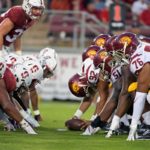
Attendance and Ratings
In the 2017-2018 season, college football experienced its most significant decrease in game attendance that it has seen in more than thirty years. The 129 Football Bowl Subdivision schools experienced an attendance decrease of 1,409 fans per game from 2016.[i] In 2017 FBS schools’ average attendance was 42,203 fans per game, which is the lowest average since 1997.{ii}
Also, every network experienced a decline in ratings except Fox and FS1 which saw a 23% and 4% increase respectively.[iii] CBS saw a 10% decrease in ratings, ABC saw an 18% decrease, NBC saw a 3% decrease, and ESPN saw a 6% decrease.[iv] College football is not alone as the NFL also suffered a decline in ratings (though total viewership was up). Many blame the NFL’s decrease on the protest during the national anthem, but it was not. However there is no such protest in college football, so why is college football experiencing a downward trend in game attendance and in television ratings?
What Caused The Decline?
Could it be Millennials and their lack of interest in paying exorbitant prices to attend a four-hour game? Tickets to college football games are entirely too high. Regular season single-game tickets can range from as low as $90 to upwards of $500. Tickets to bowl games and college football playoff games can cost over one thousand dollars. On top of that, parking can add another $30 to $50. Those prices are steep, especially for recent college graduates who are facing student loan debt.
Could it be the lack of competitive non-conference home games? In addition to high ticket prices, highly competitive games are infrequent and inconsistent. The lack of quality non-conference games by Power 5 conferences is going to be the slow death to attendance and tv ratings. The amount of competitive non-conference schedules has declined as Power 5 football programs have focused on wins and fewer losses instead of quality wins. More wins, despite the quality, equates to high rankings for bids to bowl games and to clench college playoff berths. Schools have attempted to pull the wool over fans’ eyes by scheduling a big neutral site game pretending to make the entire schedule better. Many teams, particularly SEC teams play one respectable non-conference game and three non-competitive games. Who wants to show up to watch that? Win or lose, fans will more frequently show up to see an exciting matchup against a quality opponent rather than a game they are assured to win by 30+ points.
Or could the decline be due to the allure of streaming a game on a smartphone while attending a tailgate, indulging in great food and booze? Millennials who make up the greater portion of recent college graduates opt out of purchasing tickets to attend live games and watch the games in the comfort of their homes, at a bar with friends, or at tailgates with booze and better food than the overpriced fair sold at stadium concession stands. Many fans contend that watching the games elsewhere is not only less expensive, but are also more relaxing and in some ways more enjoyable.
The reason college football is experiencing a decrease in game attendance and ratings is simple; it is a combination of all of the aforementioned factors. Will college football see another decrease in game attendance and viewership for the 2018-2019 season? This remains to be seen, but colleges will most certainly be headed in that direction if they do not address these issues and provide fans with a competitive, fun, and unique experience. This leads to the question of how can colleges fix these problems and provide fans with a competitive, fun, and unique experience that will increase attendance at college football games in this fast-paced technologically driven society where people have extremely short attention spans?
The Fix
First, colleges need to increase the number of competitive non-conference home games. Scheduling a neutral site game does not negate the rest of a terrible non-conference schedule. Fans are consumers and must be given a quality product. The quality of the college football product suffers from blowout non-conference home games against Nobody State that fans may leave at halftime. Scheduling competitive non-conference home games will keep up the excitement throughout the entire season, which will help to re-invigorate the fan base. For example, if Oregon, Alabama, Florida, and all other Power 5 schools scheduled “home-and-home” games that alternated on each other’s home field both fan bases would be excited and energized. The opportunity to see both teams play a highly competitive game that each fan base is unable to see during regular conference play would drive attendance.
Second, colleges should strive to find ways to bring elements of the tailgating experience into the stadium. One step that some colleges have already taken and that more may want to consider is the selling of alcohol at games. Another step would be to make the food at the concessions a better bang for the buck by increasing food options and quality. A couple of NFL teams, namely the Atlanta Falcons and the Baltimore Ravens, have offered cheaper and more fan-friendly menus that have already yielded positive results. Colleges should heed the Falcons and Ravens examples and follow suit.
Third, colleges should work to help the three-hour+ game time pass by more quickly by increasing fan engagement by providing fans with a unique experience that cannot be had elsewhere. Colleges may seek to do this through the use of an interactive app that would allow fans to interact with the game from the stands. Doing this may make Millennials and other fans feel differently about the cost of tickets and become more willing to pay to attend a game to participate in a unique experience that they cannot get at a bar or at a tailgate. This may also re-invigorate student interest in attending games as student attendance has steadily declined.
If colleges begin to do these things, they would be able to market attending football games as an experience that cannot be had by consuming the game in any other way. In doing so colleges will also increase fan interest in viewing the games. Colleges need to act now to re-invigorate fan interest in attending college football games while there are still some fans who are willing to pay to attend.
[i] Dennis Dodd, College Football Heads in the Wrong Direction with Largest Attendance Drop in 34 Years, CBS Sports (Feb. 13, 2018), https://www.cbssports.com/college-football/news/college-football-heads-in-wrong-direction-with-largest-attendance-drop-in-34-years/.
[iii] George Wrighster, Congratulations Fans and College Football Committee: Ratings are DOWN, Unafraid Show, ( Dec. 12, 2017), https://unafraidshow.com/congratulations-fans-and-college-football-committee-ratings-are-down/.





2 Comments
I am saddened to write this as a Michigan fan, but as I see it, the whole football system is rigged so that teams like Michigan Ohio State Notre Dame and others will always get into the big games and leave lesser teams out. I have tried for years to overlook this flaw because I liked one of the teams that even thought they sucked were allowed to play in a big bowl game for one rea$on only. Leaving out UCF(or 2016 Western Michigan) not just 1 but 2 years in a row after they go undefeated is a slap in the face of what should be called an amazing accomplishment.
I will say if UCF and others decide to leave and start their own system I will gladly watch and support them and even buy a teams jersey and try to get to a game or 2.
I watched less than 1/2 of an entire college football game this year, and those numbers will continue to decline until the broken system is fixed. Also spent 0$ on football related costs such as jerseys sweatshirts or food drinks.
For me it’s not because of any of these issues, it’s because I began seeing the same introduction of politically hateful and racially divisive attitudes that NFL players(like Colin Kapernick) have brought to the NFL being mirrored in the NCAA.